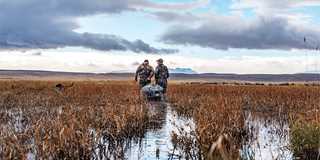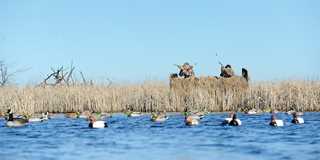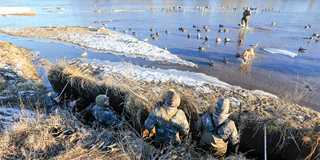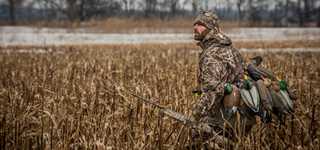Public Land Playbook
Seven tips to help you outsmart ducks—and the competition—on public hunting areas
Seven tips to help you outsmart ducks—and the competition—on public hunting areas
By Chris Jennings
I remember drawing tokens for blind locations from a half-rusted Folgers Coffee can at Turtle Creek Reservoir in Indiana when I was 16 years old. Plunging my hand into the can, I knew my prospects for the mornings hunt were riding on the luck of the draw. Top-seven picks were ideal, but anything below 15 would mean long odds for a productive morning. Vivid memories from those early-morning blind drawingsthe sign-in table, the line of bleary-eyed hunters, and the smell of strong coffee and dried mudstill give me a jolt of excitement.
More than two decades later, Ive learned that the blind you draw or other location that youre dealt on public hunting areas isnt the end game. Success depends on your approach, knowledge, and in many cases motivation. The following seven tips from veteran waterfowlers are helpful reminders that finding success on public land isnt a matter of random luck but rather of skill and determination.

Photo Michael Cligan
Knowing your quarry is a must in any type of hunting situation, but its essential when pursuing waterfowl on public lands. Why are birds visiting that particular property, what food sources are they after, and, perhaps most important, when are they using certain habitats? The answers to these questions can put you on birds, but first you have to know what to look for.
Water depth can determine where ducks feed, and the best hunting areas for dabbling ducks are often pretty shallow. Teal forage in water depths of six inches or less, while bigger puddle ducks like mallards and pintails can feed in up to 18 inches of water, says DU Chief Scientist Dr. Tom Moorman. Anything deeper than that will be loafing or roosting habitat, which ducks tend to use at different times of day from foraging areas.
This information, along with knowledge of preferred waterfowl food sources, will help you locate potential dabbling duck hot spots. If youre hunting seasonal wetlands, keep an eye out for annual seed producers, Moorman says. Its a good idea to be able to identify the most common types of these plantswild millet, smartweed, panic grass, fall panicum, and bearded sprangletop, just to name a few.
These natural waterfowl food sources can offer a road map to where dabbling ducks will gather to feed. Even areas that are dry early in the fall can fill up with birds later in the season when inundated by fall rains or backwater flooding. Moorman explains that you can tell how likely it is that an area will flood by looking at online satellite imagery. Google Earth is a great tool to identify different habitats and evidence of hydrology. We use it regularly on the science side of our waterfowl habitat work. This technology allows you to see the footprint of seasonal wetland basins, which can tell you if an area will hold water, he says. Your scouting should begin with food sources and water depth, then just follow the ducks, or try to find suitable habitats the birds are likely to move into when the weather changes.

Photo Jim Thompson
Steve Hawkinson, a Mossy Oak waterfowl pro staff member, has spent the past 28 years hunting on national wildlife refuges near Sacramento, California. The refuges in this area hold spectacular concentrations of ducks and geese, but with this abundance of birds comes intense hunting pressure. Hawkinson hunts primarily in areas that dont have permanent blinds, where waterfowlers can tuck into the tules (bulrushes) for concealment. To get away from the crowds, he has come up with an innovative form of concealment that allows him to hunt in areas with little or no vegetation.
In the places I hunt, the ducks learn quickly to avoid anything that looks like a blind or big patch of tules, Hawkinson says. I load my Jet Sled with a MoMarsh Invisi-Chair and a few decoys, and head straight out to the open water. Theres nowhere for anyone to hide, so most hunters dont even try to go out there.
Setting up in open water puts him right in the middle of the ducks, and away from other hunters competing for large stands of vegetation. I just pop up my Invisi-Chair and put a few bundles of tules around me on the chair, and it can be amazing. I use very few decoys and keep calling to minimum. It takes a little extra effort, but its worth it.
Another way that Hawkinson sets himself apart from the competition is by deploying a decoy spread with a different look. Most of the hunters in my area use two dozen to four dozen mallards, a dozen pintails or other species, and a spinning-wing decoy or two, he says. All the spreads look exactly the same. I want my spread to look natural and not like anyone elses.
As hunting pressure mounts throughout the season, Hawkinson switches to a truly unorthodox spread, consisting of only a dozen coots and two mallard decoys. There are coots all over the refuge, and as the season progresses, other ducks associate these rafts of coots with safety, he explains. Its amazing how difficult mallards are to decoy in this area later in the season, but my coot spread has improved my success. Just having something that looks different makes a huge difference.

Photo dougsteinke.com
The early bird might get the worm, but there are times when the advantage may go to hunters who dont mind missing a classic duck-blind sunrise. Alex Lang, of Sedalia, Missouri, hunts several conservation areas in the central portion of the Show-Me State. All these properties have rest areas where hunting is prohibited. This allows waterfowl to gather in large numbers adjacent to hunting areas. Lang explains that these birds wise up after a few weeks of hunting pressure and learn to wait out impatient hunters, who often give up by midmorning, especially on cold, windy days.
We go to the draw station to get our card, then head into town for breakfast, Lang says. There are times that we dont even show back up at the hunting area until ten oclock.
By this time, most of the shooting has subsided, there are fewer hunters wailing on duck calls, and the birds gain a sense of security as the afternoon approaches. We used to spend a lot of mornings watching empty skies, and then at ten thirty the ducks would start showing up. This happened so often, we started planning our hunts around that late-morning flight, Lang says. Weve used this tactic on several public hunting areas, and its worked on all of them.
Some of the nations best public hunting opportunities can be found on rivers, but the swift current in these waterways can present unique challenges for waterfowlers, especially when it comes to setting decoys. We typically hunt the ends of sandbars and willow stands, says Aaron Vogler, who has pursued ducks and geese for nearly two decades on Indianas Wabash and White Rivers. You want to put the majority of the decoys on the downwind side of the bar in the slack water. That will give you the most natural look.
Vogler explains that ducks often work decoys differently on rivers than on lakes and marshes. I see hunters along rivers using a typical puddle duck or marsh spread, with two groups of decoys and a landing zone in the middle, he says. That doesnt work well on rivers because of the way that ducks approach decoys in moving water. They will usually land on the upwind side of the decoys, often in the current off the sandbar, then swim into the slack water with the decoys. Knowing that ducks are going to land outside the spread, I recommend finding a place to hide upwind of the decoys and as close to the moving water as possible to get good shots.
Mossy Oak pro-staffer Worth Osgood hunts waterfowl on Virginias Back Bay near the North Carolina border. This storied estuarys rich beds of submersed aquatic vegetation attract impressive numbers of migrating and wintering ducks, and much of the bay is open to the public. Like other estuaries that consist largely of open water, however, Back Bay can be a challenging place to hide. Concealment is the most important thing for me on public land, Osgood says. You have to give the ducks credit: they are pretty good at picking out blinds and people.
To overcome this challenge, Osgood uses a mobile concealment system to hide his boat within the marsh grass that flourishes along Back Bays shorelines. I have owned several different boat blinds over the years but just couldnt get them to work as well as I wanted them to, he says. I was looking for something that was much more natural and would help me blend in without a rigid outline, and thats why we started using Tanglefree panel blinds.
Osgood thoroughly brushes the collapsible panels with natural vegetation gathered on the bay. When he reaches the spot that he plans to hunt, he pulls the boat as far as possible into the grass, and then unfolds the panels and sets them up on the side of the boat facing the water. The lightweight panels are easy to set up and take down and can be stowed in the boat while running to and from the hunting area.
Osgood notes that his attention to detail doesnt stop with the panels. He spends additional time brushing the boats bow, stern, and motor with grass mats and natural vegetation. Out here, if theres even a patch of metal or a section of the motor showing, its all over, he says. You have to pay close attention to your hide. 
Photo Bill Konway
When I was in the US Navy, the saying loose lips sink ships was driven into sailors heads to preserve operational security for the entire fleet. Basically, it meant keeping your mouth shut about upcoming deployments. The same mentality should apply to those who hunt on public land, because sharing your successesespecially on social mediamight result in increased competition on already crowded hunting areas.
With our group, its understood to keep our hunting spots secret, says Lang, who personally has nearly 160,000 Instagram followers. We post a lot on social media, but we arent giving away any of our locations. You have to be careful because there are hunters out there who will be looking very carefully at your posts.
Even posing for a photo at a boat ramp can lead other hunters to a secret honey hole. If you do plan to post an image from a huntand there is nothing wrong with doing sopay attention to whats in the background. Highly recognizable landmarks, trees, power lines, and signs can all reveal your location.
We ask all our guests not to post any pictures or other information about where we are hunting, Lang says. If someone breaks the rules, they probably wont be invited back, and most people know that.
Finding ducks on public land can be difficult, and if youre doing the legwork, theres no sense in giving it all away. Lang notes that this strategy can work both ways. Misinformation can be spread just as easily online. In the end, be careful about what you readand shareon social media about waterfowl hunting on public land, at least until the season is over.
Ducks Unlimited uses cookies to enhance your browsing experience, optimize site functionality, analyze traffic, and deliver personalized advertising through third parties. By continuing to use this site, you agree to our use of cookies. View Privacy Policy